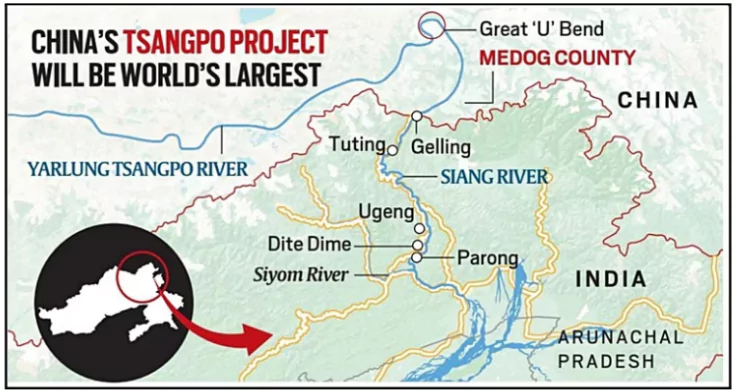On 25 December 2024, China approved the construction of the world’s largest hydropower project on the Yarlung Tsangpo (also known as the Zangbo) river in Tibet.
Background
- China 14th Five-Year Plan: The dam’s location is noted in China’s 14th Five-Year Plan at the “Great Bend,” where the Yarlung Tsangpo curves in Medog county before entering Arunachal Pradesh.
- Largest Hydro Project: Once completed, the 60,000 MW project will generate three times the electricity of the world’s largest hydroelectric dam, the Three Gorges Dam on the Yangtze River in central China.
- Path of the Yarlung Tsangpo: The Yarlung Tsangpo flows through Tibet, entering India’s Arunachal Pradesh where it is known as the Siang River.
- It continues into Assam, where it merges with tributaries like the Dibang and Lohit, becoming the Brahmaputra. The river eventually enters Bangladesh before flowing into the Bay of Bengal.

- Why Does China Want This Mega Project?: China justifies the project as a means to transition away from conventional energy sources and achieve net carbon neutrality by 2060.
- The steep descent of the Yarlung Tsangpo makes it an ideal location for hydroelectric power generation, ensuring a high flow rate necessary for efficient energy production.
Enroll now for UPSC Online Classes
Concerns for India
The project is “risky, dangerous, and irresponsible” due to the challenging terrain and the large reservoir planned for the dam.
- India as Lower Riparian State: India, as the lower riparian state, is particularly vulnerable to changes in the flow of water from the Yarlung Tsangpo.
- The majority of the Brahmaputra’s water originates in Tibet, and any alteration in its flow could severely impact India’s agriculture, water resources, and local biodiversity.
- Moreover, large dams often result in unintended consequences, such as interruption of silt flow, which is vital for maintaining soil fertility.
- Ecological and Seismic Risks: The region is ecologically fragile and earthquake-prone, making the construction of such large dams particularly concerning.
- Lessons from the Past: A 2004 landslide created Parechu Lake in the Tibetan Himalayas near Himachal Pradesh.
- After China alerted India, the lake’s level was monitored daily.
- When it burst in June 2005, water rushed down the Sutlej, but timely coordination minimized the damage.
- Need for Cross-Border Coordination: Diplomats and other experts emphasize the importance of coordination and data-sharing between India and China to mitigate risks.
- China’s reluctance to cooperate more closely with downstream countries has raised concerns, as seen in the Mekong River Basin, where 12 Chinese dams have had adverse effects on neighboring countries.
India-China Cooperation on Transboundary Rivers
- Existing Mechanisms and Agreements: India and China have some frameworks in place for cooperation on transboundary rivers, including the Memorandum of Understanding (MoU) on the Brahmaputra and Sutlej rivers.
- The Brahmaputra MoU, which lapsed in 2023, is in the process of renewal.
- However, these agreements have seen interruptions and do not fully address the need for year-round data sharing, as seen in the case of the Sutlej MoU, which remains pending renewal.
- Expert Level Mechanism: An Expert Level Mechanism set up in 2006 provided for annual meetings between the two sides, but the process has seen interruptions.
- Limitations of Current Cooperation: Despite the existence of an umbrella MoU signed in 2013, there has been minimal activity under this agreement.
- India and China are not signatories to the 1997 United Nations Convention on the Law of the Non-Navigational Uses of International Watercourses, but India follows key aspects of the convention, particularly the principle of equitable and reasonable utilization of water resources.
India’s Response and Options
- Raising Concerns More Forcefully: India must take a more assertive approach in addressing its concerns with China, especially given the high stakes involved.
- Need for a Transparent Dialogue: India must push for greater transparency and cooperation from China, especially regarding the scale of the Tsangpo project.
- Failure to do so could result in a situation where the project would have lasting detrimental effects on India’s water security and regional stability.
Check Out UPSC NCERT Textbooks From PW Store
Conclusion
The construction of the world’s largest hydropower project on the Yarlung Tsangpo River presents significant concerns and risks for India. If these concerns are not addressed adequately, they could lead to serious long-term consequences for India.
![]() 7 Jan 2025
7 Jan 2025


